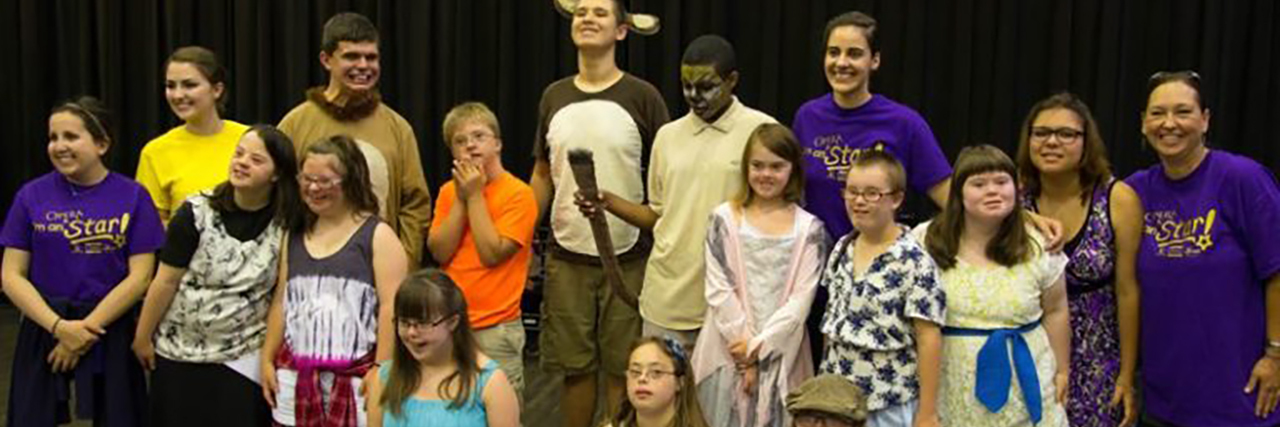“Inclusion is not just a program, policy, or idea… Inclusion is a way of life.” But what is inclusion? What does it really mean to “include everyone,” especially in consideration of children and youth with disabilities who require adaptation to participate in the many opportunities of life? As a person with a disability and as an instructor for an inclusive theatre program, I have learned through experience what inclusion can be and what it often is not.
With questions mounting about how to support an inclusive mindset, I am encouraged by the increasing number of people who stand beside me in the goal of increasing inclusion for people with disabilities everywhere: at schools, in the arts, and in our communities.
Down the Halls and At the Lunch Tables
I was honored last December to speak at my old high school‘s “Diversity Day.” Diversity Day at this school has existed for almost three years, but has never before included the disability perspective. I was excited to find that inclusion, particularly for this segment of the population, was already on the minds of the students who walk the halls I once rolled through.
There were five people on the panel asked to share their perspectives on the culture they represent; how had it affected their inclusion in society and access to opportunities? To be honest, I thought these teenagers wouldn’t ask me much. As many people with a disability can attest to, typical teenagers aren’t normally the best at communicating with someone they see as functionally “different.” When questions began, the floodgates opened — in my direction.
Student A: “How were you treated when you went to school here?”
My Answer: “Well, I had to learn how to advocate for myself because the system was not set up for me to be able to pursue opportunities and be successful. I had to find my own ways to be a part of classes, events, and programs because of inaccessibility. It is a common reality among people with all types of disabilities and differences that the barriers are those that are set up by society: they’re in the mindsets and assumptions — therefore in the actions — of what someone who moves differently or thinks differently can or cannot do, can or cannot be.”
Student B: “How were things set up for Special Ed and students with disabilities when you were here?”
Answer: “When I attended school, I was one of only two General Ed students with a severe disability. The majority of Special Ed students were in the POHI rooms: a pair of self-contained classrooms along the darkest hall towards the back of the building, frequented by very few other students. These students did not:
- Walk the halls with their General Ed peers
- Join in after school clubs or teams
- Enjoy lunch with their peers, but instead stayed at one table in the corner of the general lunchroom
Student C: “It is still just like that! It sounds like it really bothers you; why isn’t there more integration?“
Answer: “That is what advocating is all about! Speaking up for yourselves and for the way you want your school to be! Speak up for how everyone has value. As for integration, I’ve heard someone describe integration as “people with disabilities having a table in the corner of the lunchroom; but inclusion is having accommodations available and having the opportunity to sit wherever the heck someone wants!”
Spotlight on Inclusion
As the idea of inclusion as a mindset spreads, so do the opportunities being offered to young people with disabilities. For example, the inclusive theatre program I work for is constantly finding new ways to create success in the arts for young people of all abilities. I never know quite what to expect when rolling into the first session of a 4th Wall workshop. No matter the specifics, I always find a unique variety of abilities that may call for adaptations to ensure success for every student.
For example, the current class I am teaching is filled with talent and differences that exist in every Inclusive class. Some students are gifted speakers, while others are more comfortable expressing themselves through movement. Every song is performed with accompanying sign language gestures, so students can sing according to their abilities. Also, every student chooses what their character will be in every play we have, and scripts are written by the instructors, with the unique talents of each student in mind. The best part of every class, in my opinion, is that the students share fun and laughter with their peers, across abilities. The way I see it, theatre is a great equalizer — it is King Inclusive!
In the Community
Inclusivity belongs in schools, at programs and activities, but most importantly in the community. Creating an inclusive view in every form of public life will continue to demonstrate that individuals with disabilities of all types make up part of the tapestry of what society should be. Disability in all its forms is part of the norm! As that mindset continues to develop, so will the laws and practices that dictate opportunity, access and acceptance.
This story originally appeared on 4th Wall Kids.
Photo via 4th Wall.

